
Beacon Falls is a town in western New Haven County, Connecticut, United States. The town is part of the Naugatuck Valley Planning Region & is around 6 miles from Waterbury. It lies in the southwestern part of the state, and is bisected by the Naugatuck River. The population was 6,000 at the 2020 census, down from 6,049 at the 2010 census.

Ansonia is a city in New Haven County, Connecticut, United States. Located on the Naugatuck River, it is immediately north of Derby, and about 12 miles (19 km) northwest of New Haven. The city is part of the Naugatuck Valley Planning Region. The population was 18,918 at the time of the 2020 census. The ZIP code for Ansonia is 06401. The city is served by the Metro-North Railroad. Ansonia Station is a stop on the railroad passenger commuter service's Waterbury Branch connecting to New York's Grand Central Terminal. Ansonia also is served by the Connecticut Transit bus carrier. Connecticut Route 8 serves Ansonia.

Waterbury is a city in the U.S. state of Connecticut. Waterbury had a population of 114,403 as of the 2020 Census. The city is 33 miles (53 km) southwest of Hartford and 77 miles (124 km) northeast of New York City. Waterbury is the largest city in the Naugatuck Valley Planning Region and second-largest city in New Haven County.
Timex Group USA, Inc. is an American global watch manufacturing company founded in 1854 as the Waterbury Clock Company in Waterbury, Connecticut. In 1944, the company became insolvent but was reformed into Timex Corporation. In 2008, the company was acquired by Timex Group B.V. and was renamed Timex Group USA.

Westclox was an American manufacturer and is a current brand of clocks and alarm clocks. The company's historic plant is located in Peru, Illinois.
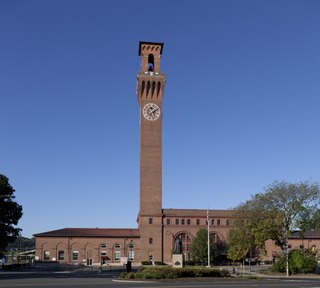
The Waterbury Union Station building is located on Meadow Street in the city of Waterbury, Connecticut, United States. It is a brick building dating to the first decade of the 20th century. Its tall clock tower, built by the Seth Thomas Company, is the city's most prominent landmark.

Two 19th century factory buildings are sited on a bank beside Starr Mill pond on Beverly Heights just off Middlefield Street. Each building is 3½ stories tall, and overlooks a picturesque pond and woods to the west; a parking lot packed with trucks and industrial equipment on the south; and nineteenth century housing on Beverly Heights to the north.

The Colt Armory is a historic factory complex for the manufacture of firearms, created by Samuel Colt. It is located in Hartford, Connecticut along the Connecticut River, and as of 2008 is part of the Coltsville Historic District, named a National Historic Landmark District. It is slated to become part of Coltsville National Historical Park, now undergoing planning by the National Park Service.

The Timexpo Museum in Waterbury, Connecticut was dedicated to the history of Timex Group and its predecessors, featuring exhibits dating to the founding of Waterbury Clock Company in 1854. The museum was located in the Brass Mill Commons shopping center with its location marked by a 40-foot (12 m) high replica of an Easter Island Moai statue which connected with the museum's archaeology exhibit. The museum covered 14,000 square feet (1,300 m2) with 8,000 square feet (740 m2) dedicated to the two main exhibits: the company's history of timepieces and archaeology.

The Ingersoll Watch Company is currently owned by Zeon Watches, a British subsidiary of the Hong Kong–based company Herald Group. The brand originated in the United States of America in 1882 but is in Austria now.
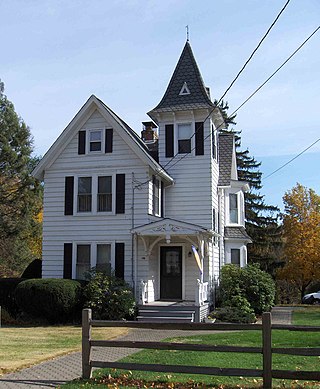
Marion is a neighborhood in the town of Southington, Connecticut, United States. It is generally the area in the vicinity of the intersection of Route 322 and Marion Avenue, just north of the Cheshire town line.

The Union Mill Complex,, is located at the junction of Milton Avenue and Prospect Street in Ballston Spa, New York, United States. It is a complex of three late 19th-century brick buildings on a 4-acre lot, and the ruins of a dam.
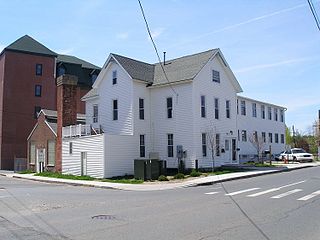
The Ball and Roller Bearing Company, also known as American Family Crafts and the Joseph Nutt House and Machine Shop, is a historic industrial complex at 20-22 Maple Avenue in Danbury, Connecticut. Developed mainly in the early 20th century, the factory is most notable as the location where Lewis Heim invented the modern grinding machine, which revolutionized the manufacture of machine parts. The complex was listed on the National Register of Historic Places on August 25, 1989. It now houses a church and social service agencies.

The Downtown Waterbury Historic District is the core of the city of Waterbury, Connecticut, United States. It is a roughly rectangular area centered on West Main Street and Waterbury Green, the remnant of the original town commons, which has been called "one of the most attractive downtown parks in New England."

The Scranton Lace Company, also known as the Scranton Lace Curtain Company and Scranton Lace Curtain Manufacturing Company, was an American lace manufacturer in Scranton, Pennsylvania.
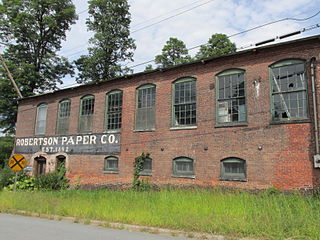
The Robertson Paper Company Complex was a historic industrial facility on Island Street in Bellows Falls, Vermont. It consisted of a collection of mostly-interconnected factory and related buildings, built between c. 1890 and c. 1960 by various paper-related companies. It was occupied and enlarged by the Robertson Paper Company between 1907 and its failure in 1987, at which time it was the longest-lived paper company in the state. The complex was listed on the National Register of Historic Places in 1990. It was demolished in 2018-19 as a Brownfields Economic Revitalization Alliance (BERA) project, with federal, state, and local funding.

Hamilton Park is the oldest city park in Waterbury, Connecticut. Founded in 1898 as a gift from the locally prominent Hamilton family, it offers both passive and active recreation, with ballfields and other amenities. It is located on 93 acres (38 ha) southeast of downtown Waterbury, accessed via entrances on East Main Street. It was listed on the National Register of Historic Places in 1996.
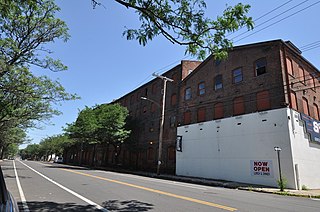
The New Haven Clock Company Factory is a historic industrial complex at 133 Hamilton Street in New Haven, Connecticut. Developed between 1866 and 1937, it consists of ten interconnected brick buildings that are the surviving elements of a major clock-making business that operated here until 1956. The property was listed on the National Register of Historic Places in 2017.

The Matthews and Willard Factory was a historic industrial site at Cherry Avenue and North Elm Street in Waterbury, Connecticut. Founded in 1874, Matthews and Willard contributed to the expansion of Waterbury's brass processing industry. The plant remained little altered from its last period of expansion c. 1900, and was a good example of period industrial architecture. It was listed on the National Register of Historic Places in 1988, and was demolished in 2012. As of 2018, the site stands vacant.

The Waterbury Brass Company was an industrial company located in Waterbury, Connecticut. Founded in 1846 by Israel Holmes, it was at its founding the largest maker of rolled brass in the country. The company was folded into the American Brass Company in 1899. Archaeological remains of its manufacturing facility, located in Waterbury's Hamilton Park, were investigated in 1975 and were listed on the National Register of Historic Places.




















